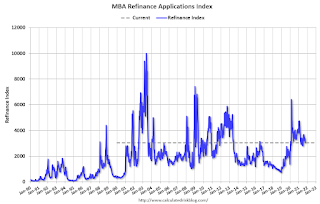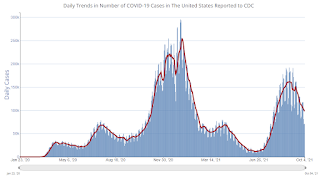by Calculated Risk on 10/07/2021 08:35:00 AM
Thursday, October 07, 2021
Weekly Initial Unemployment Claims Decrease to 326,000
The DOL reported:
In the week ending October 2, the advance figure for seasonally adjusted initial claims was 326,000, a decrease of 38,000 from the previous week's revised level. The previous week's level was revised up by 2,000 from 362,000 to 364,000. The 4-week moving average was 344,000, an increase of 3,500 from the previous week's revised average. The previous week's average was revised up by 500 from 340,000 to 340,500.The following graph shows the 4-week moving average of weekly claims since 1971.
emphasis added
 Click on graph for larger image.
Click on graph for larger image.The dashed line on the graph is the current 4-week average. The four-week average of weekly unemployment claims increased to 344,000.
The previous week was revised up.
Regular state continued claims decreased to 2,714,000 (SA) from 2,811,000 (SA) the previous week.
Note (released with a 2 week delay): There were an additional 647,690 receiving Pandemic Unemployment Assistance (PUA) that decreased from 1,059,248 the previous week (there are questions about these numbers). This was a special program for business owners, self-employed, independent contractors or gig workers not receiving other unemployment insurance. And threre were an additional 630,814 receiving Pandemic Emergency Unemployment Compensation (PEUC) down from 991,813.
Weekly claims were lower than the consensus forecast.
Wednesday, October 06, 2021
Thursday: Unemployment Claims
by Calculated Risk on 10/06/2021 08:00:00 PM
Thursday:
• At 8:30 AM ET, The initial weekly unemployment claims report will be released. The consensus is for 345 thousand initial claims, down from 362 thousand last week.
October 6th COVID-19: Slow Progress
by Calculated Risk on 10/06/2021 05:12:00 PM
| COVID Metrics | ||||
|---|---|---|---|---|
| Today | Week Ago | Goal | ||
| Percent fully Vaccinated | 56.1% | 55.9% | ≥70.0%1 | |
| Fully Vaccinated (millions) | 186.4 | 185.5 | ≥2321 | |
| New Cases per Day3 | 96,757 | 109,273 | ≤5,0002 | |
| Hospitalized3 | 65,162 | 75,426 | ≤3,0002 | |
| Deaths per Day3 | 1,428 | 1,488 | ≤502 | |
| 1 Minimum to achieve "herd immunity" (estimated between 70% and 85%). 2my goals to stop daily posts, 37 day average for Cases, Currently Hospitalized, and Deaths 🚩 Increasing 7 day average week-over-week for Cases, Hospitalized, and Deaths ✅ Goal met. | ||||
IMPORTANT: For "herd immunity" most experts believe we need 70% to 85% of the total population fully vaccinated (or already had COVID).
The following 22 states have between 50% and 59.9% fully vaccinated: Colorado at 59.8%, California, Minnesota, Hawaii, Pennsylvania, Delaware, Florida, Wisconsin, Texas, Nebraska, Iowa, Illinois, Michigan, Kentucky, South Dakota, Arizona, Kansas, Nevada, Alaska, Utah, North Carolina and Ohio at 50.6%.
Next up (total population, fully vaccinated according to CDC) are Montana at 48.8%, Indiana at 48.7%, Missouri at 48.4% and Oklahoma at 48.1%.
 Click on graph for larger image.
Click on graph for larger image.This graph shows the daily (columns) and 7 day average (line) of positive tests reported.
1st Look at Local Housing Markets in September; Denver, Las Vegas and San Diego
by Calculated Risk on 10/06/2021 11:33:00 AM
Today, in the Newsletter: 1st Look at Local Housing Markets in September
Excerpt:
Here is a summary of active listings for these housing markets in September. Inventory was down 1.0% in September MoM from August, and down 36.6% YoY.
Inventory in San Diego is at an all time low, whereas inventory in Denver is up 107% (about double) from the all time low in March of this year. Las Vegas inventory is up 74% from the record low in April. Most markets have seen active inventory increase from earlier this year, but San Diego and Miami are plumbing new lows.
ADP: Private Employment increased 568,000 in September
by Calculated Risk on 10/06/2021 08:19:00 AM
Private sector employment increased by 568,000 jobs from August to September according to the September ADP® National Employment ReportTM. Broadly distributed to the public each month, free of charge, the ADP National Employment Report is produced by the ADP Research Institute® in collaboration with Moody’s Analytics. The report, which is derived from ADP’s actual data of those who are on a company’s payroll, measures the change in total nonfarm private employment each month on a seasonally-adjusted basisThis was well above the consensus forecast of 430,000 for this report.
“The labor market recovery continues to make progress despite a marked slowdown from the 748,000 job pace in the second quarter,” said Nela Richardson, chief economist, ADP. “Leisure and hospitality remains one of the biggest beneficiaries to the recovery, yet hiring is still heavily impacted by the trajectory of the pandemic, especially for small firms. Current bottlenecks in hiring should fade as the health conditions tied to the COVID-19 variant continue to improve, setting the stage for solid job gains in the coming months.”
emphasis added
The BLS report will be released Friday, and the consensus is for 460 thousand non-farm payroll jobs added in September. The ADP report has not been very useful in predicting the BLS report.
MBA: Mortgage Applications Decrease in Latest Weekly Survey
by Calculated Risk on 10/06/2021 07:00:00 AM
From the MBA: Mortgage Applications Decrease in Latest MBA Weekly Survey
Mortgage applications decreased 6.9 percent from one week earlier, according to data from the Mortgage Bankers Association’s (MBA) Weekly Mortgage Applications Survey for the week ending October 1, 2021.
... The Refinance Index decreased 10 percent from the previous week and was 16 percent lower than the same week one year ago. The seasonally adjusted Purchase Index decreased 2 percent from one week earlier. The unadjusted Purchase Index decreased 2 percent compared with the previous week and was 13 percent lower than the same week one year ago.
“Mortgage applications to refinance dropped almost 10 percent last week to the lowest level in three months, as the 30-year fixed rate increased to 3.14 percent – the highest since July. Higher rates are reducing borrowers’ incentive to refinance, as declines were seen across all loan types,” said Joel Kan, MBA’s Associate Vice President of Economic and Industry Forecasting. “Purchase activity also fell, driven by a drop in conventional loan applications. Government purchase applications were up over 1 percent, but that was still not enough to bring down the average loan balance of $410,000. With home-price appreciation and sales prices remaining very elevated, applications for higher balance, conventional loans still dominate the mix of activity.”
...
The average contract interest rate for 30-year fixed-rate mortgages with conforming loan balances ($548,250 or less) increased to 3.14 percent from 3.10 percent, with points increasing to 0.35 from 0.34 (including the origination fee) for 80 percent loan-to-value ratio (LTV) loans.
emphasis added
 Click on graph for larger image.
Click on graph for larger image.The first graph shows the refinance index since 1990.
With low rates, the index remains elevated - but the recent bump in rates has slowed activity.
The second graph shows the MBA mortgage purchase index
 According to the MBA, purchase activity is down 13% year-over-year unadjusted.
According to the MBA, purchase activity is down 13% year-over-year unadjusted.Note: The year ago comparisons for the unadjusted purchase index are now difficult since purchase activity was strong in the second half of 2020.
Note: Red is a four-week average (blue is weekly).
Tuesday, October 05, 2021
Wednesday: ADP Employment
by Calculated Risk on 10/05/2021 08:11:00 PM
Wednesday:
• At 7:00 AM ET, The Mortgage Bankers Association (MBA) will release the results for the mortgage purchase applications index.
• At 8:15 AM, The ADP Employment Report for September. This report is for private payrolls only (no government). The consensus is for 430,000 jobs added, up from 374,000 in August.
Update: Framing Lumber Prices Up Year-over-year
by Calculated Risk on 10/05/2021 04:03:00 PM
Here is another monthly update on framing lumber prices.
This graph shows CME random length framing futures through October 5th.
 Click on graph for larger image in graph gallery.
Click on graph for larger image in graph gallery.There were supply constraints over the last year, for example, sawmills cut production and inventory at the beginning of the pandemic, and the West Coast fires in 2020 damaged privately-owned timberland (and maybe again in 2021).
October 5th COVID-19: 7-Day Average Cases Falls Below 100K, Lowest since August 3rd
by Calculated Risk on 10/05/2021 03:13:00 PM
| COVID Metrics | ||||
|---|---|---|---|---|
| Today | Week Ago | Goal | ||
| Percent fully Vaccinated | 56.0% | 55.8% | ≥70.0%1 | |
| Fully Vaccinated (millions) | 186.1 | 185.3 | ≥2321 | |
| New Cases per Day3 | 97,909 | 111,851 | ≤5,0002 | |
| Hospitalized3 | 66,131 | 76,734 | ≤3,0002 | |
| Deaths per Day3 | 1,444 | 1,492 | ≤502 | |
| 1 Minimum to achieve "herd immunity" (estimated between 70% and 85%). 2my goals to stop daily posts, 37 day average for Cases, Currently Hospitalized, and Deaths 🚩 Increasing 7 day average week-over-week for Cases, Hospitalized, and Deaths ✅ Goal met. | ||||
IMPORTANT: For "herd immunity" most experts believe we need 70% to 85% of the total population fully vaccinated (or already had COVID).
The following 22 states have between 50% and 59.9% fully vaccinated: Colorado at 59.8%, California, Minnesota, Hawaii, Pennsylvania, Delaware, Florida, Wisconsin, Texas, Nebraska, Iowa, Illinois, Michigan, Kentucky, South Dakota, Arizona, Kansas, Nevada, Alaska, Utah, Ohio and North Carolina at 50.2%.
Next up (total population, fully vaccinated according to CDC) are Montana at 48.8%, Indiana at 48.7%, Missouri at 48.3% and Oklahoma at 48.1%.
 Click on graph for larger image.
Click on graph for larger image.This graph shows the daily (columns) and 7 day average (line) of positive tests reported.
On Private Lenders Raising the "Conforming Loan Limit"
by Calculated Risk on 10/05/2021 12:33:00 PM
Today, in the Newsletter: On Private Lenders Raising the "Conforming Loan Limit"
Excerpt:
Some private mortgage industry participants have already increased their “conforming loan limits” in anticipation of the FHFA raising the CLL. This is NOT an official increase.
...
Note that they are only raising the “limit” from $548,250 (low cost areas) to $625,000. That is a 14% increase, and the FHFA will probably increase the limit closer to 18% (like to around $645,000 or so).



